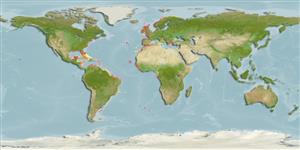Pycnogonida |
Pantopoda |
Endeidae
Environment: milieu / climate zone / تغييرات عمق / distribution range
بوم شناسي
موجوداتی که در محدوده وسیعی از آبهای آزاد از نزدیک بستر و یا روی کف بستر، در قسمت های میان آبی تا سطح آب و در برخی گونه ها با قابلیت پرواز، زندگی و تغذیه می کنند.; تغييرات عمق 0 - 12 m (مرجع 256). Subtropical
Western Atlantic and the Mediterranean.
Length at first maturity / Size / Weight / سن
بلوغ: Lm ? range ? - ? cm Max length : 0.3 cm BASL جنس نر / بدون خواص جنسي; (مرجع 276)
Length: Females, 0.4 cm; males smaller (Ref. 256); 3 mm body length; legs 15 mm long (Ref. 276). Body: Slender-cylindrical, with the lateral processes wide apart, each furnished with a dentiform projection at the tip. Cephalon: Frontal spines close together, the collar having sinus in the middle on the dorsal side. Chelifores and palps: absent. Abdomen: oblong-oval, truncate at the posterior end; armed with a short spine. Ocular tubercle: exactly in the middle of the cephalon, prominent, acuminate, the four eyes comparatively small, closer to the base of the tubercle. Proboscis: long and slender than the body, expanded in the middle. Ovigerous legs: male only, half the length of the body, with seven segments. Second segment: largest, the 5th segment larger than preceding or succeeding it, sharply curved; last segment triangular, with two short spines on the inner margin. Ambulatory legs: 3 times the length of the body, armed with scattered spines, unequal in length; 2nd coxal segment longer than taken together; femur twice as the coxal section and terminating outwards in a conical process, armed with two spines of different length. Tibia: 1 shorter. Tibia: as long as the femur. Tarsus: obliquely rounded. Propodus: four times longer than broad, terminating outwards in a sharp corner, inner margin furnished at the base with five spines, the two outmost placed side by side, terminal claw more than half the propodus. Auxiliary claws: less than half as the main claws. Body: translucent, with the intestine and its lateral expansions of a green color (Ref. 256). Proboscis: Detritus-gathering as a different source of food, lack chelifores, and capable of considerable movement at the region of the 'soft collar'; a number of bifid setae scattered on the surface and sometimes groups of tactile or chemosensory spines abundant around the mouths of this detritus-feeding forms. The mouth at the tip of the proboscis: triradiate structure; three lip-lobes and carry a number of setae (Ref. 12)
Feeding on hosts: Debris at the base of Antennularia sp. (Ref. 234). Coastal to slope (Ref. 19). Planktonic (Ref. 91956). Epibiotic (Ref. 116112). Larva develops attached to the hydranth of Obelia sp. (Ref. 121217). Chemically attracted to various hydroid species (Ref. 121217). Reported to be exclusively detritivorous (Ref. 121217).
Life cycle and mating behavior
بلوغ | تولید مثل | تخم ریزی | Eggs | Fecundity | Larvae
Life cycle: release a number of eggs at each mating; represents the contents of a single femur (Ref. Ref. 12). Development site of larval associations: Obelia medusae and hydroids (Ref. 206).
مآخذ اصلی
مراجع | هماهنگ كننده | همكاران
de Kluijver, M.J. and S.S. Ingalsuo 2005 Pycnogonida: Microbenthos of the North Sea. Zoological Museum, University of Amsterdam.http://ip30.eti.uva.nl/bis/pycnogonida.php?menuentry=inleiding[accessed13/01/06]. (مرجع 256)
وضعيت در فهرست قرمز IUCN
(مرجع 130435: Version 2025-1)
وضعيت از نظر سايتس (مرجع 108899)
Not Evaluated
Not Evaluated
خطر برای انسان ها
استفاده انسانی
| FishSource |
ابزارها
اطلاعات بيشتر
Population dynamicsرشد
Max. ages / sizes
Length-weight rel.
Length-length rel.
نوسانات طولی
Mass conversion
فراواني
Life cycleتولید مثلبلوغFecundityتخم ریزیEggsنمو تخمLarvae PhysiologyOxygen consumption
Human RelatedStamps, coins, misc.
منابع اينترنتي
Estimates based on models
Preferred temperature
(Ref.
115969): 8 - 27.9, mean 20.2 (based on 1604 cells).
Fishing Vulnerability
Low vulnerability (10 of 100).
طبقه قيمت
Unknown.
